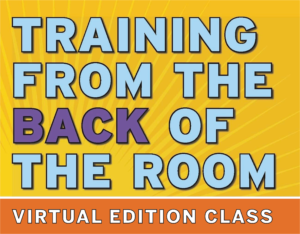5 Considerations for Remote Class Delivery – Contributed by Torsten W. Hansen and Vispi Shroff
 The world has been through a huge, forced transformation affecting most aspects of life and routines as we used to know them. In particular, how we collaborate, learn, and exchange information have all been severely impacted. We need to rethink how we teach/train others.
The world has been through a huge, forced transformation affecting most aspects of life and routines as we used to know them. In particular, how we collaborate, learn, and exchange information have all been severely impacted. We need to rethink how we teach/train others.
Many of us suddenly find ourselves working from home or, even worse, we have lost our jobs and are now looking for another income stream. However, for us as teachers and trainers, the current situation calls for online (virtual, remote) delivery and lots of online meeting facilitation. Remote teaching/training has moved from being a lesser desirable format to the only possible format for most classroom instruction right now.
On a personal note, we (Torsten and Vispi, co-founders of Agile Training) have designed a “Product Owner Class” (according to guidelines created by ICAgile). We designed the class for remote delivery and this has lead to several considerations and choices we had to make in the process. Below are 5 design decisions we made.
1. Design for Remote Delivery, not F2F.
Training that works well in the face-to-face classroom will most likely NOT work well in a remote environment. Moving an 8-hour class directly to online delivery will most certainly lead to webinar fatigue at some point during the class. When learners are tired, their attention lags and less information is learned/retained. In addition, many classroom exercises are poorly suited for remote delivery.
We decided to split the Product Owner Class into 10 sessions over several days, with each session lasting 90 minutes. A few days before each session, the participants received an emailed “Call Guide.” The Call Guide contained the following items: pre-class connection activities to do prior to the call/class, exercises and graphic organizers to use during each session, and post-class activities. Utilizing the time between sessions was a great opportunity for deeper connections and concrete practice activities.
 2. Know Your Tools.
2. Know Your Tools.
Technical issues can really obstruct the flow of the class and the focus of the learners. If you do find that you are distracted with numerous technological issues, it could be worth looking into other tools that could help with productivity. Of course, technical issues can arise at any time, so it could be important to be prepared for this. Examples are: you’re unable to move learners into breakout rooms, learners can’t access the collaboration tool, learners can’t figure out how to add virtual sticky notes to the whiteboard, the screen freezes, audio is lost, or the whole system goes down.
For our Product Owner Class, we kept the class as low tech as possible. Most of the information and exercises were in the Call Guide and shared through Google Docs. Learners also had all this information in a digital Learner’s Handbook that they downloaded. In addition, the Call Guide also contained the “Back-Up Plan” – what participants should do if their technology (or ours!) failed.
In situations where we needed more advanced online collaboration tools, we stopped teaching content and demonstrated or, at the minimum, explained how the virtual tool was used. Or we engaged learners in a separate exercise that focused on learning how to use the new collaboration tool.
3. Start Soft and Start Early.
In face-to-face classroom training, the learners are expected to arrive early, grab a coffee or tea, find a seat, and chat with the other learners. In most remote sessions, learners often arrive just on time or even a few minutes late. This doesn’t allow for the participants to get grounded and centered for the learning that is about to happen. Nor does it allow time for participants to check their Internet connection with the class platform (software) or to check their own audio/visual equipment.
We invited and encouraged the class participants to join early. As they arrived, we moved them into breakout rooms of three to allow for small talk and conversations about topics related to the training. We figured that this was the equivalent of grabbing a coffee and finding a seat in a physical classroom.
4. Co-Facilitation is a Must.
In the face-to-face classroom, trainers can prepare a lot of things ahead of time. We can also ask the learners to help set up posters, distribute material etc. In a virtual environment, trainers do not have the same options for asking anyone else to assist (or perhaps we just don’t know how to do that yet!).
In our virtual Product Owner Class, we designed the class for co-facilitation (there were two of us teaching and taking care of the technology). Co-facilitation provided a better learning experience all around. One of us focused on the content and delivery, while the other trainer focused on context, technology and flow (i.e. preparing breakout rooms, answering questions in the chat box, watching time and observing the group dynamic).
 5. Use Dual Monitors for Video.
5. Use Dual Monitors for Video.
In the classroom, the biggest challenge is often how to get the projector to work. In an online setting, there are a number of possible issues with audio, video, screen sharing and file access.
In our experience, using dual monitors was a great plus. We could see all learners on one monitor and we shared files and content from the other screen (at least this was true for Zoom when we selected the dual option).
We also found it very important to have access to a high-quality web-camera, mic and speaker. Because we knew that computer microphones often distort sound, we used quality headsets instead. And because we knew that built-in computer cameras are also usually less than adequate, we used small, external web-cams that we clipped onto our computers. We each had our own computer, headset, and camera so we didn’t need to share equipment and so that, if one of us lost our Internet connection, the other trainer could carry on with the class.
Finally, we provided some guidance and instructions for the learners so that they knew how to use the video/sound features on the virtual platform we were using.
Conclusions.
Remote training is often considered a disadvantage when compared to face-to-face classroom instruction. As we designed our Product Owner Class, we came to realize that there were also a number of benefits to virtual training: we could deliver the training in small chunks, we could use the time between sessions to deepen the learning to “make it stick,” and no one needed to spend time/money traveling. These were just a few of the benefits we noticed from designing/delivering virtual classes versus face-to-face ones.
We now believe that the key to a great remote learning experience is to embrace the format and options fully. We encourage you to take advantage of the format rather than letting it be a limitation.
Finally, as we are still designing and learning, we would appreciate any ideas or questions you might have. Email us at [email protected] or leave a message at https://agiletraining.eu/contact/
********************************
About the Authors:

Torsten Werchmeister Hansen, Denmark

Vispi Shroff, Ireland
Vispi Shroff is an Agile enthusiast and co-founder of Agile Training. Since 2006, Vispi has worked with various organizations and teams to successfully adopt Agile values and principles. Vispi is passionate about Agile because he has seen and experienced its transformative power in enabling teams and businesses to respond to increasingly complex and changing times. To contact Vispi, email him at [email protected].
********************************

Thanks, Lorene – glad you found the article helpful! Stay safe! 🙂 Sharon
Good article with great suggestions. Thank you. I like the co-facilitation part.